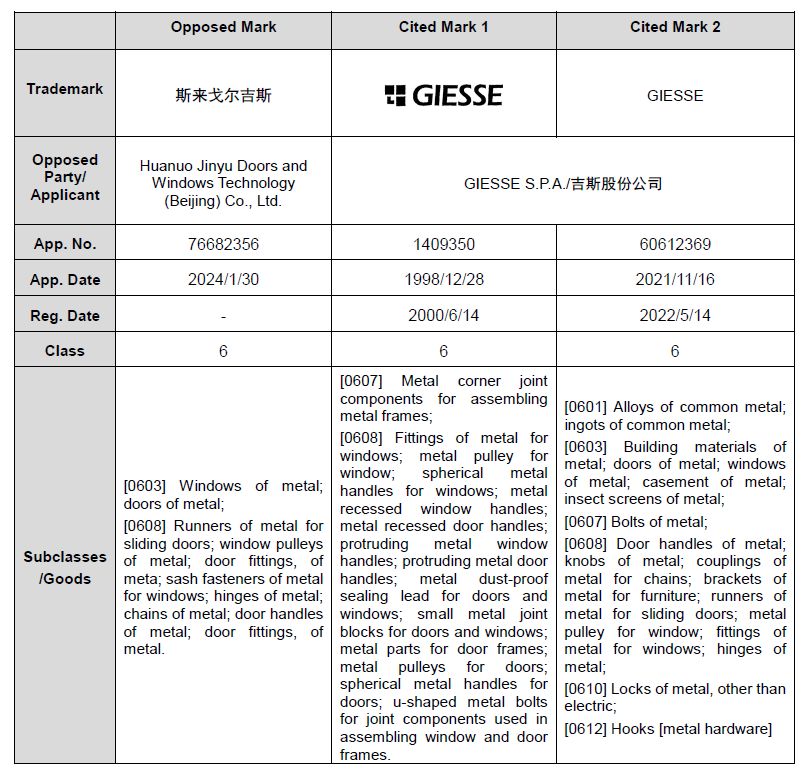Abstract
We, Kangxin Partners, P.C., filed an opposition action against the trademark, 斯来戈尔吉斯 (No. 76682356 in Class 6) ("the opposed mark") on behalf of GIESSE S.P.A./吉斯股份公司 ("client") on July 29, 2024. The National Intellectual Property Administration, PRC ("CNIPA") examined the case and decided to reject the opposed mark for registration.
Background
The client is a globally recognized manufacturer of hardware
accessories for doors and windows and has registered the trademarks
" ![]() " and "GIESSE" in
mainland China for various goods, including those in Class 6. The
client's trade name "GIESSE/吉斯" is
highly distinctive.
" and "GIESSE" in
mainland China for various goods, including those in Class 6. The
client's trade name "GIESSE/吉斯" is
highly distinctive.
The client was of the opinion that the distinctive word part "吉斯" of the opposed mark is a "similar mark over similar goods" compared with their prior registered marks. We were entrusted to file opposition against this mark.
The comparison of the marks is as below:

Key Issues
In the opposition, we mainly argued that:
1) The Chinese characters "吉斯" included in the opposed mark are the transliteration of the client's "GIESSE" mark, and therefore the marks constitute "similar marks," in violation of Article 30 of China Trademark Law;
2) The client enjoyed prior trade name rights for "吉斯/GIESSE" and the registration of the opposed mark infringes the client's prior trade name rights. According to Article 32 of China Trademark Law, the opposed mark should not be approved for registration;
3) The opposed mark was filed without the intention to use, but with malignity and by improper means, in violation of good faith principle and Articles 4, 7, and 44 of China Trademark Law.
On March 13, 2025, the CNIPA issued the decision and rejected the opposed mark, 斯来戈尔吉斯 (App. No. 76682356) for registration, mainly reasoning that the opposed party applied for the opposed mark is clearly intentional copy and imitation of the client's mark. This behavior not only misleads consumers but also undermines fair competition in the market. Additionally, it contravenes the spirit of the Trademark Law, which prohibits obtaining trademark registration through deceptive or otherwise improper means.
Inspiration of the Case
In this case, even though we submitted a substantial amount of evidence to prove that "吉斯/GIESSE" has formed a stable corresponding relationship and enjoys high recognition in the industry, the CNIPA did not support our argument. However, the CNIPA did support our argument regarding the opposed party's bad faith. Specifically, the opposed party not only registered the mark for "吉斯" but also separately applied for the client's English mark for "GIESSE", without providing a reasonable explanation for the creative origin of this. Therefore, the CNIPA determined that the opposed party had clear intentions of copying and imitating another's mark, and finally decided not to approve the registration of the opposed mark.
Conclusion
From this case, it is evident that the CNIPA is increasingly strict in its crackdown on malicious trademark registrations. For agents handling such cases, it is essential to thoroughly prepare and discuss opposition materials from the following perspectives during the initial stages:
1. Comprehensive Preparation of Evidence
- When filing a trademark opposition, the agent should communicate with the client in advance to prepare comprehensive evidence, including the trademark's usage history, reputation, and market impact.
2. In-depth Analysis of Trademark Similarity
- The agent should conduct an in-depth analysis of the similarities between the marks, including aspects such as words, pronunciation, and appearance.
3. Reasonable Explanation of the Trademark's Origin
- Based on the client's trademark history, explain the origin of the cited mark to enhance its distinctiveness.
4. Comprehensive Investigation of the Opponent's Trademark Application History
- Conduct a full investigation into the history of the opposed party's applications to determine whether there is any instance of applying for registration of well-known trademarks owned by others.
The content of this article is intended to provide a general guide to the subject matter. Specialist advice should be sought about your specific circumstances.


